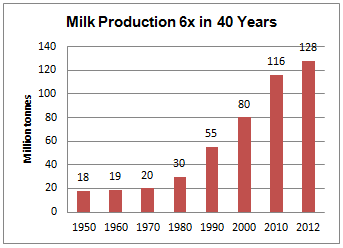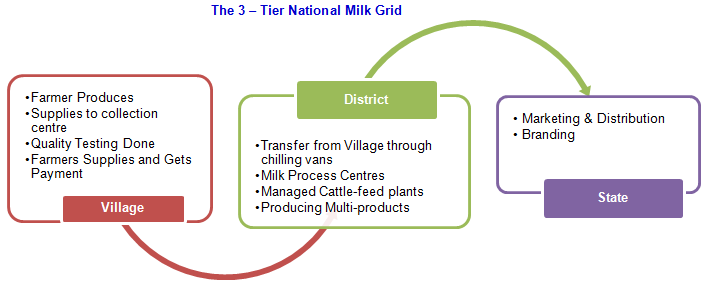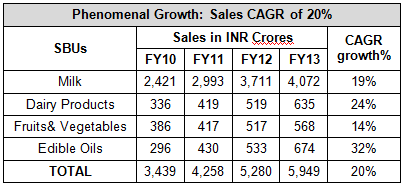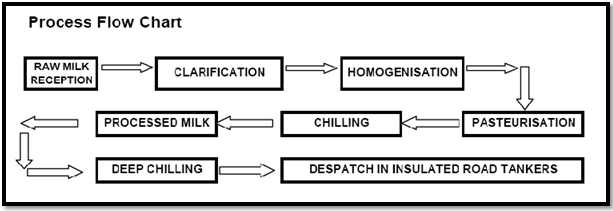From the severe milk shortages of the 70's to being the world's largest milk producer towards the end of 20th century, India has come up a long way. In its endeavor to cope up with the milk deficit, a nationwide transformational movement under the banner of 'Operation Flood' was announced in 1970 and implemented in 3 phases over the next fifteen years. It was credited to be the world's largest dairy development program and involved large scale improvement in productivity of livestock, collection, storage, processing & transportation of milk. India holds a distinct position today, with almost 17% of the world's milk production in 2013.

Creation of the Milk Grid: In the 70s, India livestock landscape was completely fragmented, with millions of farmers, each with just few cows at their disposal. Prior to Operation Flood, these farmers produced adequate milk on a daily basis but had no way of delivering this highly perishable product to the cities where demand for milk was burgeoning. Impressed by the success of a dairy cooperative union in Anand district of Gujarat, the Government of India established the National Dairy Development Board (NDDB) and mandated it to expand the Anand pattern of dairy cooperatives throughout India. The NDDB conceived and developed the Operation Flood program, which organized dairy farmers into cooperatives, introduced technological advances to help them produce more milk, and created a national milk gridÂÂ linking India dairy cooperatives with major cities through an efficient supply chain ecosystem consisting milk production, procurement, processing, and marketing.

 While 'Amul' has always been considered as the pioneer of White revolution in India, another player who has silently become a significant contributor to the success of the Indian Dairy industry has been Mother Dairy. Established in 1974 by the NDDB under the 'Operation Flood' program, Mother Dairy started as a milk selling unit and has since then diversified to various other milk by-products, fruits, vegetables & edible oil to become Rs6,000cr dairy conglomerate. In the process it has acquired impeccable penetration in the Delhi/NCR market where it occupies the leadership position. Over the past 5 years, the company has grown its revenues by 20% CAGR and grabbed a significant market share away from its competitors in key markets of Delhi, Mumbai, Hyderabad and Kolkata.
While 'Amul' has always been considered as the pioneer of White revolution in India, another player who has silently become a significant contributor to the success of the Indian Dairy industry has been Mother Dairy. Established in 1974 by the NDDB under the 'Operation Flood' program, Mother Dairy started as a milk selling unit and has since then diversified to various other milk by-products, fruits, vegetables & edible oil to become Rs6,000cr dairy conglomerate. In the process it has acquired impeccable penetration in the Delhi/NCR market where it occupies the leadership position. Over the past 5 years, the company has grown its revenues by 20% CAGR and grabbed a significant market share away from its competitors in key markets of Delhi, Mumbai, Hyderabad and Kolkata.

 Mother Dairy today is the second largest player in the Indian Dairy market second only to Gujarat Co-operative Milk Marketing Federation Ltd. (GCMMF) which retails the Amul brand. Mother Dairy sells about 3.2 million liters of milk everyday, of which ~80% is sold in Delhi, where it has 66% market share in the branded milk segment. The company has made significant inroads in other markets such as Mumbai, where it entered only 4 years ago and is in the 2nd position in the fresh fermented dairy products (dahi, lassi) and the 3rd position in the ice cream segment. Mother Dairy's success has been an outcome of its unrelenting focus on quality, innovative distribution models and a deep understanding of local consumer preferences which has enabled the company to grow despite stiff competition from local and international peers.
Mother Dairy today is the second largest player in the Indian Dairy market second only to Gujarat Co-operative Milk Marketing Federation Ltd. (GCMMF) which retails the Amul brand. Mother Dairy sells about 3.2 million liters of milk everyday, of which ~80% is sold in Delhi, where it has 66% market share in the branded milk segment. The company has made significant inroads in other markets such as Mumbai, where it entered only 4 years ago and is in the 2nd position in the fresh fermented dairy products (dahi, lassi) and the 3rd position in the ice cream segment. Mother Dairy's success has been an outcome of its unrelenting focus on quality, innovative distribution models and a deep understanding of local consumer preferences which has enabled the company to grow despite stiff competition from local and international peers.

An enviable network secures milk supplies
 Mother dairy has been able to efficiently capitalize on the strong three tier milk grid that NDDB has managed to build over the years. While earlier it was difficult for small farmers owning 2-3 buffaloes to sell their milk directly to end users, the efficient 3 tier milk grid system has successfully managed to connect the small farmer to the urban milk consumer. Moreover, the farmer gets immediately paid for the milk delivered, thus reducing his dependence on credit. With a strong focus on farmer welfare and the strong equity among milk producers, Mother Dairy has successfully managed to establish supply side security. Compared to this, big multinationals like Nestle and Danone have met with limited success in securing milk supplies despite deep pockets and long history in the country. Mother Dairy's strong supply side will remain a key competitive advantage for the long term given that building such a large supply chain is a long drawn process.
Mother dairy has been able to efficiently capitalize on the strong three tier milk grid that NDDB has managed to build over the years. While earlier it was difficult for small farmers owning 2-3 buffaloes to sell their milk directly to end users, the efficient 3 tier milk grid system has successfully managed to connect the small farmer to the urban milk consumer. Moreover, the farmer gets immediately paid for the milk delivered, thus reducing his dependence on credit. With a strong focus on farmer welfare and the strong equity among milk producers, Mother Dairy has successfully managed to establish supply side security. Compared to this, big multinationals like Nestle and Danone have met with limited success in securing milk supplies despite deep pockets and long history in the country. Mother Dairy's strong supply side will remain a key competitive advantage for the long term given that building such a large supply chain is a long drawn process.
Strong processing capabilities & robust supply chain
Milk is a highly perishable commodity and the process from procurement to consumption is extremely critical. Over the years, Mother Dairy has been successful in developing a lean and optimal supply chain model which has enabled them to deliver quality products to its consumers at affordable prices. In its dairy business, the company has the unique distinction of operating a mini reverse supply chain where a portion of milk which is delivered to milk booths daily is brought back to the processing plant to check for contamination in the intermediate supply chain. In its fruits & vegetable business, it procures fresh produce from 16 states and delivers them straight to its outlets thus eliminating middlemen and benefiting both farmers and consumers. All these processes have yielded results and Mother Dairy has successfully positioned itself as a high quality brand in the minds of the consumer.
Another success factor for a company largely operating in a low involvement product category is a strong distribution network since the consumers do not make extra efforts to buy the product. With 175,000 outlets vending its edible oil Dhara,15000 stores selling Mother Dairy ice creams countrywide, 29,000 retail points vending its dairy products and 350 odd SAFAL stores selling fruits & vegetables, Mother Dairy has already established a strong retail footprint across segments to satisfy the rising consumer demand.
Deep understanding of local customer preferences
The Indian consumer preferences are complex in nature. While the consumer expects the product to be of international standards, the preference for local flavors is entrenched in Indian taste buds. Mother Dairy has successfully managed to design its products to suit the taste buds of the Indian consumers. In the ice cream category, while it was quick to introduce local flavours like 'Paan', 'Golgappa', it innovated further by offering Indian sweet delicacies like Thandai and Shahi Meva in Ice cream flavors. These flavors have been instant hit with consumers and enabled Mother Dairy to make strong inroads in the ice cream category. In the dairy category, localized products like 'Misthi Dahi'(Sweetned Curd) and 'Tadka Chach'Â (Butter Milk) have performed extremely well and a host of low fat products focused on the health conscious Indian consumer have found strong traction. Constant product innovation keeping in mind the evolving tastes and preferences of the Indian consumer have contributed immensely to the success of Mother Dairy.
Future Roadmap
Mother Dairy is all set to aggressively expand its operations in key states of India in which it has low penetration presently. By 2014-15, the company aims to reach the revenues of Rs10,000cr, expand its presence to the top 25-30 cities of India and generate 35% of its revenues from outside the NCR region. To meet these targets the company is planning to widen its product portfolio with a bigger thrust on value-added products like ice-creams, fermented milk and fruit-based drinks even as it explores new areas like frozen ready-to-eat offerings.
The dairy market in India is poised to grow strongly in the coming years and co-operatives like Mother Dairy will face stiff competition from Multi nationals like Britannia, Nestle, etc. With competition rising, it would be interesting to see if these institutions with a strong socio economic purpose manage to grow the way they have been growing in the past. With a robust backend supply chain in place and a strong competitive positioning, we think Mother Dairy is well positioned to fend off competition and grow sustainable in the coming years.

